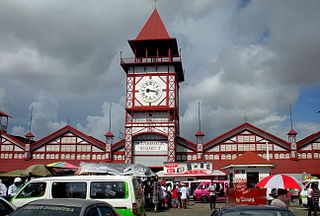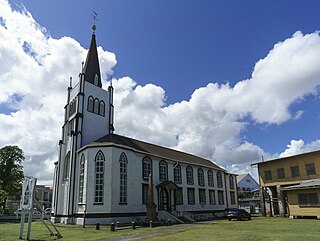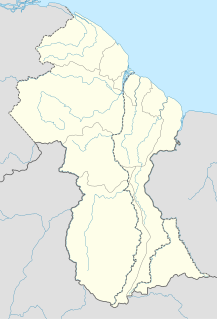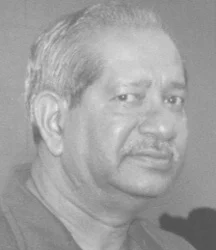
Georgetown is the capital and largest city of Guyana. It is situated in Demerara-Mahaica, region 4, on the Atlantic Ocean coast, at the mouth of the Demerara River. It is nicknamed the "Garden City of the Caribbean." It is the retail and administrative and financial services centre of the country, and the city accounts for a large portion of Guyana's GDP. The city recorded a population of 118,363 in the 2012 census.

New Amsterdam is the regional capital of East Berbice-Corentyne, Guyana and one of the country's largest towns. It is 100 kilometres (62 mi) from the capital, Georgetown and located on the eastern bank of the Berbice River, 6 km (4 mi) upriver from its mouth at the Atlantic Ocean, and immediately south of the Canje River. New Amsterdam's population is 17,329 inhabitants as of 2012.

Stabroek Market is the largest market of Georgetown, Guyana. Located in the centre of the capital city, the market is housed in an iron and steel structure with a prominent clock tower.

St. Andrew's Kirk is one of the oldest buildings in Georgetown, Guyana that has been continually in use for religious purposes. The Dutch Reformed congregation laid its foundations in 1811. However, due to financial difficulties it was acquired by Scottish Presbyterians and was formally opened for service on 28 February 1818.

David Arthur Granger is a Guyanese politician and retired military officer who served as the 9th President of Guyana from May 2015 to August 2020. He served for a time as Commander of the Guyana Defence Force and subsequently as National Security Adviser from 1990 to 1992. He was Leader of the Opposition in the National Assembly of Guyana from 2012 to 2015.
Aubrey Cummings was a renowned Guyanese musician and singer, who in 1978 migrated to Barbados. He was also an artist.
The National Library of Guyana is the legal deposit and copyright library for Guyana. Unlike many national libraries, it is also a public lending library and the headquarters of Guyana's public library service, with branches extending throughout the country. Founded in 1909, the National Library of Guyana is situated on the corner of Church Street and Main Street in central Georgetown. In 2007, the library recorded a collection of 397,893 books and a total of 22,058 members. Its collection includes the papers of A. J. Seymour and Ian McDonald.

The following outline is provided as an overview of and topical guide to Guyana:
Andrew Morrison, SJ was a Guyanese Roman Catholic Jesuit priest, journalist, and pro-democracy activist.
Stephen Campbell was an Arawakan Guyanese politician and political activist, and the first Amerindian member of Parliament in Guyanese history.

Stewartville is a village district in Guyana on the Atlantic coast of West Demerara, just east of the mouth of the Essequibo River. There are four sections in the village: Stewartville Housing Scheme, Sarah Lodge, Stewartville Old Road and Stewartville Sea View.
Edward Rupert Burrowes was a Guyanese artist and art teacher who founded the Working People's Art Class (WPAC), the first established art institution in Guyana. The E R Burrowes School of Art, an undergraduate institution accredited by the University of Guyana, is named after him.
The Working People's Art Class (WPAC), founded by Edward Rupert Burrowes in 1945, was the first established art institution in the colony of British Guiana, now the country of Guyana. A number of well-known Guyanese artists were taught at the WPAC.
Bourda Cemetery is an eighteenth-century cemetery situated on Bourda Street in Georgetown, Guyana. Formerly known as "Bourda's Walk", Bourda cemetery is the oldest cemetery in Georgetown, and the only surviving plantation cemetery in the city. It is considered a national landmark and has been listed as a monument by the National Trust of Guyana.
The Georgetown Seawall Bandstand is an iron bandstand that is situated on the western end of Georgetown Seawall in Guyana. It is one of three bandstands in Georgetown, the other two being situated in the Botanical Gardens and the Promenade Gardens.
Ignatius Scoles SJ was a Roman Catholic Jesuit priest, architect and writer. He designed churches and civic buildings and was the son of Joseph John Scoles.

Sase Narain was a Guyanese politician and lawyer. He served as Speaker of the National Assembly of Guyana from 1971 to 1992, becoming the longest serving Speaker in Guyana.

The COVID-19 pandemic in Guyana is part of the worldwide pandemic of coronavirus disease 2019 caused by severe acute respiratory syndrome coronavirus 2. The virus was confirmed to have reached Guyana on 11 March 2020. The first case was a woman who travelled from New York, a 52-year-old woman suffering from underlying health conditions, including diabetes and hypertension. The woman died at the Georgetown Public Hospital.

Red House located in Kingston, Georgetown, was the official residence of the Colonial Secretary and later the Premier of British Guiana. As of 22 March 2000, it houses the Cheddi Jagan Research Centre.











